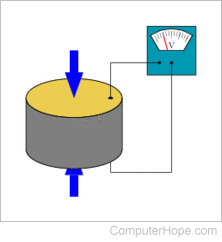Piezoelectric
Updated: 10/01/2023 by Computer Hope

Piezoelectric is a material capable of converting mechanical energy into electric energy and vice versa. Piezoelectricity was discovered by French physicists Jacques and Pierre Curie in 1880 and means electricity resulting from pressure and latent heat.
The piezoelectric effect allows crystal microphones, phonographs, and strain gauges to work by turning mechanical movement into voltage. This reverse effect is also used with headphones and inkjet printer nozzles.
Piezoelectric materials
Below are examples of materials that exhibit piezoelectricity.
- Crystals (e.g., berlinite, gallium orthophosphate, langasite, lithium niobate, quartz, topaz)
- Bone
- Ceramics
- Nanostructured semiconductor
- Polymers
Tip
See the list of piezoelectric materials on Wikipedia for a complete list.
